With its compact form, the harlequin willow also fits into small gardens and is easy to care for. We explain how it grows best and what native alternatives are available.

The harlequin willow is an ornamental willow and is also called ‘Hakuro Nishki’. This indicates its East Asian origin. You can buy this undemanding and robust shrub as a shrub or tall willow. Thanks to its compact form, the harlequin willow can also be used to beautify a terrace or balcony. Depending on how you plant and care for it, it can grow up to three meters tall and one and a half meters wide. Its white-pink-green leaves add color to your garden.
How to plant and care for your harlequin willow properly
Before you plant a harlequin willow, you should first find a suitable location. The ideal place for it is either in the sun or in a semi-shaded place. Besides the location, the harlequin willow also needs loose, humusy, moist and preferably cool soil. To keep the soil cool, it is important that you always water your harlequin willow adequately. You can also plant it in a pot. However, the container should be large enough and glazed so that the soil does not dry out too quickly. It is best to use loose, peat-free potting soil.
The best time to plant the harlequin willow is in the fall or spring. It is recommended to plant it as a solitary. Dig a hole in the ground large enough to accommodate the root ball and place the young plant in it. Then fill the hole back up with soil and press it down at the edges. Finally, water the willow properly. If you are using a harlequin willow as a high trunk, you should tie the trunk permanently so that it can withstand the wind.
In general, the harlequin willow is easy to care for. However, there are a few things you should keep in mind. First of all, it needs sufficient water. So water it regularly and always check that the soil is moist. But make sure that there is no waterlogging. It is best to water the harlequin willow with lime-free water or rainwater. You should also fertilize in the spring at leaf emergence time. Tips for homemade and sustainable fertilizer can be found here: Fertilizer for plants: Make it yourself all natural.
Harlequin pruning: This is how you proceed
If you prune your harlequin willow regularly, you can keep the plant’s growth down. The harlequin willow is quite hardy and can tolerate pruning down to a few inches above the ground. How often you prune your harlequin willow is among the most important pruning criteria. If you want to keep the willow small, cutting it once a year is enough. Also, topiary is recommended to maintain the aesthetics of the plant.
It is best to cut your harlequin willow in February if you want to do something good for insects. The harlequin willow blooms between March and April. Its flowers serve as food for insects during this time.
When pruning the ornamental willow, keep the following in mind:
- Remove the shoots you no longer want from the stem.
- If your willow has dead, crossing or diseased branches, cut them off at the base.
- Trim the willow shoots you want to keep by two-thirds.
- Be sure to always cut above a bud.
- Try not to injure grafting points on high stems.
- Re-prune as needed in the summer.
Is the harlequin willow insect-friendly?

The harlequin willow is considered useful for insects. However, this is only the case if you prune your harlequin willow at the right time. The best time to do this is February, as there are usually no more frosty nights at this time and your harlequin willow has not yet formed flowers.
However, if you cut your harlequin willow too often, it will always sprout new leaves. Unfortunately, these are of no use to the insects, as they can serve neither with pollen nor with nectar. So if you want your harlequin willow to have an insect benefit, don’t cut it too often. Once a year is ideal. However, you can re-cut them again in the fall if needed.
The following native willows are an alternative to harlequin willow and have additional benefits for insects:
- Sal willow (Salix caprea)
- Eared willow (Salix aurita).
The male willows of the Sal and Eared willows bear conspicuous furry catkins and donate pollen primarily to insects. The female willows, on the other hand, have less showy flowers, but they contain abundant nectar.
Compared to harlequin willow, these native willows also have the advantage of being very inexpensive because they do not have to be produced by grafting. Through the process of grafting, certain plants can be propagated. You can easily purchase both the sal willow and the auric willow as young plants.

